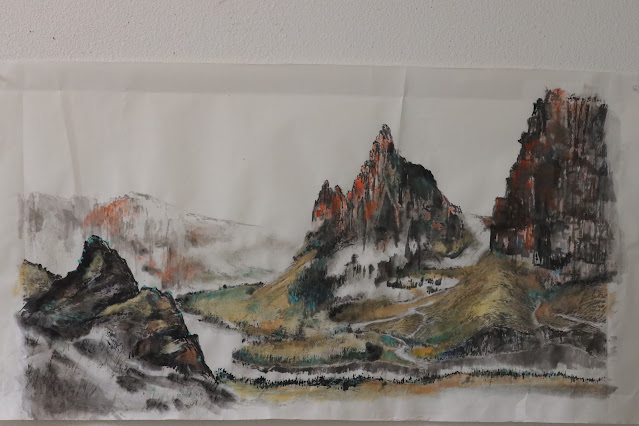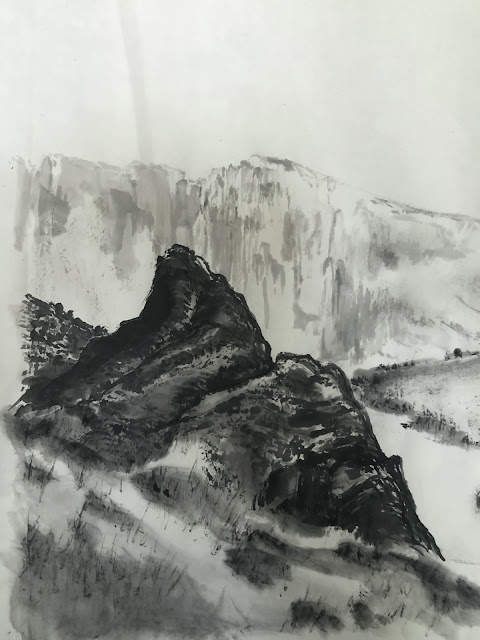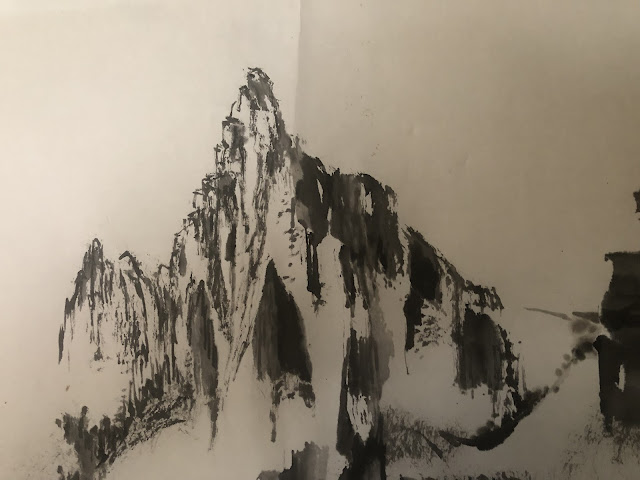I received notice that my Whiter Shade of Pale painting has been adjudicated into an exhibition. While I am elated about this opportunity I am also concerned that I must now find a proper way to display my painting, and to be able to do that before drop-off day.
My painting of the 16 Vestal Virgins was done on gold speckled Xuan paper and I chose to wet mount it with a 4 in wide white speckled Xuan border. I was trying to emulate the classical mounted scroll appearance. I had stored the painting rolled up in a mailer tube since completion of the work. The gist of the matter is that I simply can't house all my paintings in a frame; I would simply run out of storage. Having the painting mounted on paper precludes me from displaying the work as a Sulio Xuan Ban float, or a canvas mount. The only option left is to present it in a conventional picture frame.
My mounted painting with borders measures 26in x 46 in and there just aren't any ready made picture frames for that size. I was able to find a cheap custom made frame shop online that would sell a frame with backing and 060 plexiglass for around $75. Unfortunately I will need to pay a shipping cost of $50. Ouch!
My only option left is to make my own picture frame. I prefer to use 1x2 in. pine stock over my usual poplar for my frame. I think the natural color of pine will be a perfect match for my gold speckled paper and pine is quite a bit cheaper than poplar.
I am using my dado blades instead of a router to cut a shoulder into my 1x2 stock. Using a router would have required securing the skinny 1x2 stock before running the router bit over it whereas I already have a table saw and it is just a matter of changing out the saw blade and run the 1x2 stock through. A much easier and safer proposition.
Cutting a shoulder into the 1x2 stock
The shaped 1x2 stock is then cut to size, sanded down and glued and finished in clear urethane. I am not using any stains on the pine stock since I want the natural wood color to match my painting. I apply several coats of the clear urethane, with steel wool polishing between the coats.

You recall my painting has a 26 in. measurement on one side, yet a standard piece of board for backing comes in at 24 in x 48 in. That means I am 2 inches shy unless I spring for the next size up, which is 48 in x 96 in. After some consideration, I trim off one inch of my white speckled border on all 4 sides and that reduced the measurement to 24 in in width. That means I can now use the standard 24 in x 48 in board for backing. I am left with a 3 in border, which still looks good on the painting. I purchase my cut-to-size plexiglass for the cover glass from a local plastic shop.
My frame measures 44 in x 25in. and I am concerned that the pine is a little too flexible for the 44 inch span. My fear is that people would pick up the painting by the long side of the frame and cause the wood to bow. I therefore cut and screwed in an anchoring support post in the middle of the frame to help stabilize the frame. The frame is rock solid now with that bracing.
I use D-rings for anchoring my picture wire and the cut ends of the multi-strand wire is wrapped in heat-shrink tubing. I've poked myself and drew blood on the loose strands of a hanging wire thus I am extending the courtesy of shielding other handlers from potential mishap.

Here is the new home for my 16 Vestal Virgins. I am right about the natural pine being a good match for the paper. I am happy to say their new home only costs me $50, instead of the the $125 if I had bought it on mail order. This is not only more economical, but is made with love and looks great.
I am actually doing this as a journal for myself to read in a future date. I often am amused by how I invite problems by not recognizing them to begin with, and the process and remedies I take to mitigate the road blocks.
As I look at this finished product, a final step so to speak, a strange emotion overcomes me. I had stored the painting rolled up in a mailer tube, little thought was given to how to frame it to begin with, if at all. My thought process just don't extrapolate that far ahead. Or is it not counting chickens before the eggs are hatched? Anyways the emotions I am feeling is like my son has surreptitiously grown up and out of the blues he is ready for his first prom night. He is asking to borrow my tie and my dress shoes because all he has are sneakers. Thus I am fidgeting with his attire, polishing the shoes for him, taking pictures and beaming with smiles, as a proud father should be. Making sure that he is presentable to his date, his schoolmates, and the world. I am so happy that he is growing up, but secretly feeling sentimental that my days of being an empty-nester won't be too far off. So as the painting that I had spent so much time on, the painting that I have grown attached to, is getting all dolled up, I must however, need to acknowledge the fact that there's a possibility that we might be parting ways?










































